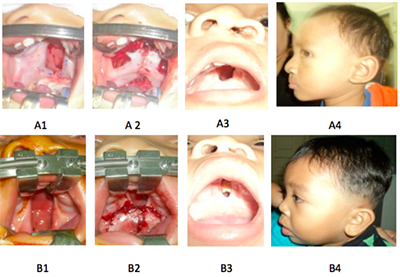Speech Outcome in Cleft Palate Patients After Soft Palatoplasty (Stage 1) in Two-Stage Palatoplasty Technique: A Review of Two Cases
DOI:
https://doi.org/10.14228/jpr.v1i4.86Abstract
Background: The challenge in palatoplasty is no longer a successful closure of the cleft palate but an optimal speech outcome without compromising maxillofacial growth. On the contrary, repairing cleft palate as soon as possible is recommended to improve speech. The surgeon proposed two-stage palatoplasty in early aged, range between 4 to 30 months. The delayed hard palate closure started approximately between the age of three years and one year after soft palatoplasty to avoid temporary retracted oral articulation of certain consonant.
Patient and Methods: 11-months old and 9-months old patients with non-syndromic unilateral cleft lip and palate had undergone soft palatoplasty. Speech was examined as a perceptual assessment, using protocol in Craniomaxillofacial Center Cipto Mangunkusumo Hospital, in the age of 29 months by an experienced speech pathologist.
Result: Patient 1 has mild hypernasality, adequate velopharyngeal competence, normal articulation pattern, phonation and speech intelligibility. Patient 2 has misarticulation pattern,which are omission or weak consonants, substitution of pharyngeal stop, mild to moderate hypernasality, mild impairment in speech intelligibility, and inadequate velopharyngeal competence.
Summary: Speech outcome is influenced by intense speech practicing done by their parents. The patient can work on the misarticulation. We need further study to know the result of speech outcome in two stage palatoplasty.

Downloads
Published
Issue
Section
License

This work is licensed under a Creative Commons Attribution-NonCommercial-NoDerivatives 4.0 International License.
Authors retain the copyright of the article and grant Jurnal Plastik Rekonstruksi the right of first publication with the work simultaneously licensed under a Creative Commons Attribution License. Articles opting for open access will be immediately available and permanently free for everyone to read, download and share from the time of publication. All open access articles are published under the terms of the Creative Commons Attribution-Non-commercial-NoDerivatives (CC BY-NC-ND) which allows readers to disseminate and reuse the article, as well as share and reuse of the scientific material. It does not permit commercial exploitation or the creation of derivative works without specific permission.













